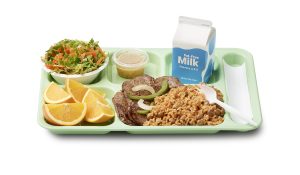The United Nations reported that 1 billion tons of the food available to humans worldwide ends up in landfills each year and that “if food waste were a country, it would be the third largest [greenhouse gas] emitting country in the world,” contributing more than 8% to global emissions.
A source of emissions as large as food waste can seem like a daunting problem meant for the food industry to tackle. However, a major source of food waste comes from somewhere most of us have eaten a lot of our meals: school cafeterias. Tackling food waste in school cafeterias could go a long way in lessening our collective environmental footprint.

What is Food Waste?
Food waste is exactly what it sounds like: food meant for humans that goes uneaten or never even makes it past production, processing, or distribution phases. This food ends up in landfills and emits a powerful greenhouse gas called methane. The buildup of excess greenhouse gasses in the atmosphere traps too much heat from the sun on Earth, leading to climate change and global warming.
How Much Food is Wasted in American Schools?
The sheer amount of uneaten school food is staggering. In total, it is estimated that U.S. schools waste 530,000 tons of food every year. Programs such as the National School Lunch Program (NSLP) are designed to ensure every student in need is fed, and therefore track food wasted in school cafeterias to identify areas of improvement. In 2018, nearly $1.2 billion worth of food from just the NSLP was thrown away.

The National School Lunch Program is vital to the work towards eliminating childhood hunger. The NSLP alone has reduced food insecurity by 14%, and feeds roughly 30 million students from low-income households at school every day. The program requires that schools serve milk, fruits, vegetables, grains, and meat/meat alternatives with every lunch. In many cases, students must take all five parts of the meal in order for the school to be reimbursed for the cost of the lunch.* This leads to students taking and discarding items they do not like, or are not hungry for, in order for the school to prevent out-of-pocket expenses.
With all the good that the NSLP does, how can we continue to make sure all students are fed, but with a more environmentally-friendly and cost-effective system?
Would Changing School Menus Eliminate Food Waste?
Schools in the U.S. are working with a low budget to meet certain nutrition standards originally set by The Healthy Hunger Free Kids Act of 2010. Working within these constraints, the cafeteria lunch menu repeats every few weeks and can get boring for students. As can perhaps be expected, fruits and vegetables are the first to be passed over and account for more than 50% of food waste in all grades. So, it may seem that an easy solution would be to provide less of what students aren’t eating and more of the meat and grains they do eat.
Well, for the past three years, many schools have done just that and the results are surprising. The COVID-19 pandemic caused food supply-chain disruptions that allowed schools to adjust meal patterns without complying to nutritional standards; they served less produce and more meats and grains. Despite these shifts towards meals that, stereotypically, kids might be attracted to, food waste continued to increase.
3 Ways to Reduce Food Waste in Schools
Throughout the years, initiatives that aim to decrease food waste from school lunchrooms have been put into motion. The solutions below are not all-encompassing, but offer a glimpse of possible paths forward.
- Offer vs. Serve: In 1975 a provision was added to the NSLP called Offer vs Serve (OVS) with the goal of reducing food waste by allowing students to decline foods they do not want to eat. In order for schools to be reimbursed under OVS, during lunch, students must take 3 out of 5 required components, one of which must be either fruits or vegetables. Currently, this provision is required to be implemented at the high school level for lunch but is still optional for lower grades.
- Ask What Students Want to Eat: By further involving students in decision-making, some schools have made adjustments to cafeteria menus to increase interest in fruits and vegetables. This includes changes like adding soup to the salad bar or providing smoothies as a fruit option. Schools have even allocated funding toward nutritional education programs to allow students to understand what eating healthy looks like and why it is important. Changes like these have the potential to eliminate the high levels of fruit and vegetable waste. Given the opportunity, students are a valuable voice in decisions that ultimately impact them the most.
- Longer School Lunch Time: It is recommended by the CDC that students have at least 20 minutes to sit and eat after getting their food. Yet, about half of the school districts in the U.S. do not require, or even recommend, this amount of time, as school days are over-packed with teachers under pressure to ready students for standardized tests and recover COVID learning loss. Lunch is one of the few times students get to socialize with peers of their choice, making even a 20 minute lunch a tight interval to eat all their food. Increasing the lunch period by as little as 5 minutes has not only been linked to a decrease in food waste, but also to increases in consuming foods with key nutrients such as fruits and vegetables.
Beyond the Lunch Line: Government Involvement to Reduce Food Waste
 Strategies of implementing Offer vs Serve, student involvement on menu items, and increasing lunchtime all show promise in decreasing the food waste produced in school cafeterias.
Strategies of implementing Offer vs Serve, student involvement on menu items, and increasing lunchtime all show promise in decreasing the food waste produced in school cafeterias.
While this is a start, schools cannot carry the elimination of waste themselves. Bi-partisan efforts are being made at the federal level to prevent, recover, reduce, and recycle food waste nationally. In order for meaningful change to be made, lawmakers must advocate for food waste solutions at all levels of the food system. Reducing food waste is a vital part in the fight to heal our planet from climate change.
*This requirement applies to elementary and middle schools. High school students are required to take 3 out of 5 offered items, one of which must be a fruit or vegetable.
Image credits: Food waste in landfill (Climate change, waste and disasters by FAO Regional Office for Latin America and the Caribbean is licensed under CC BY-NC-SA 2.0 Deed); High school cafeteria reimbursable lunch tray (Tray54 by US Department of Agriculture is Public Domain); Kids in lunchroom (Middle School students eating school lunch by US Department of Agriculture is Public domain)


